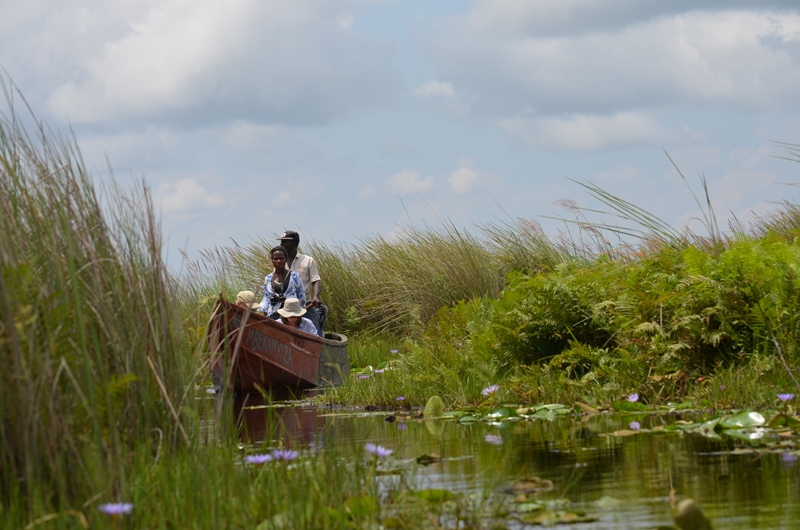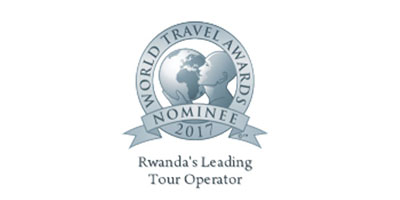Uganda parks & attractions
Mabamba swamp – wetland birding, shoebill, birds
Mabamba Wetland - home of the Shoebill

Mabamba Bay Swamp in Uganda is a prime wetland birding site famous for the Shoebill which is Uganda’s most sought after bird by Uganda birding tourists as well as by nature lovers. Mabamba Swamp is located west of Entebbe on the northern shore of Lake Victoria, covering 2424 ha with thick marshes of papyrus, water lilies and other wetland grasses.
Mabamba swamp is a Ramsar site and Important Bird Area (IBA). The wetland hosts over 300 bird species that include many globally threatened species, 7 of Uganda’s 12 Lake Victoria biome restricted species (notable is the Papyrys Gonolek) and plenty of wetland specialties. The wetland also hosts huge flocks of Paleartic migrants every year from October to March.
Mabamba Swamp can be reached by a number of routes. From Kampala or Entebbe the easiest route is via the Nakiwogo landing site in Entebbe where you take a 10 minutes ferry crossing to Kasanje landing and from there drive for about 20 minutes to Mabamba passing through cultivations and open fields that will provide plenty of garden birds.
Birding in Mabamba swamp is done from a motorized wooden boat by riding through a maze of trails cutting through the thick marshes.

The Shoebill in Mabamba Swamp and the Fishermen…

Mabamba wetland is popular for the Shoebill which is the most sought after bird by birdwatchers in Uganda. The Shoebill is also on the wildlife list of non bird watching tourists that are intrigued by its peculiar looks and massive size. The rare bird is found in few places in Uganda and Mabamba Swamp is the most accessible and reliable with the best chances of seeing the Shoebill in Uganda and arguably in Africa.
Mabamba Swamp is rich with lungfish (called “mamba” in native language) which is the favorite food for the Shoebill. However the lungfish is also one of the most sought after fish by the local fishermen, creating competition with the Shoebill. The fishermen had long held a superstition that seeing a Shoebill (locally called ‘Boolwe’) resulted in a poor catch that day. But this not far fetched because the Shoebill feeds on lungfish and where the Shoebill is the fish will go into hiding. For the fishermen it was a bad omen to see a Shoebill when one set out to fish in the wetland. They hunted the Shoebills and killed them, leading to a decline in the numbers and almost rendered them extinct in the wetland. Designating the wetland a Ramsar site in 2006 provided some protection to the Shoebill. However bird watching on the wetland brought about enlightenment to the fishermen and community. The fishermen rent out their boats to birdwatchers and make a lot of money, and even some fishermen have been trained in birding and guiding. The fishermen now protect the Shoebill, so that when they set out to fish and see a Shoebill they do not move too close not to disturb it and will gladly inform the tourists of where to see it. There is about 12 Shoebills said to be resident in Mabamba wetland.
The best time to see the Shoebill in Mabamba swamp is early morning, say 7am, before there is more activity on the wetland BUT also by this time the Shoebill is hunting for lunch fish which it does by standing in one place for a long time or even hours looking out in the water waiting for fish to cross so it scoops it with the big strong shoe-like bill that breaks the fish instant.
Other Mabamba Swamp birds

African Fish Eagle, Purple Swamphen, African Green Pigeon, African Jacana, African Marsh Harrier, African Pigmy Goose, Black Crake, Black Heron, Black-crowned Night Heron, Black-crowned Waxbill, Black-headed Heron, Black-winged Stilt, Blue Swallow, Blue-cheeked Bee-eater, Cattle Egret, Common Moorhen, Common Sandpiper, Common Sqacco Heron, Double Toothed Barbet, Glossy Ibis, Goliath Heron, Great Cormorant, Great White Egret, Great White Pelican, Green Cuckoo, Grey Heron, Grey-crowned Crane, Gull-billed Tern, Hadada Ibis, Harmerkop, Little Egret, Little Stilt, Long-tailed Cormorant, Long-toed Lapwing, Malachite Kingfisher, Marsh Harrier, Northern Brown-throated Weather, Orange Weaver, Papyrus Gonolek, Pied Kingfisher, Pied Wagtail, Pink-backed Pelican, Pin-tailed Whyda, Purple Heron, Red-eyed Dove, Red-headed Love-bird, Shining Blue Kingfisher, Speckled Mousebird, Spur-winged Goose, Spur-winged Lapwing, Swamp Flycatcher, Veilots’ Black Weaver, Village Weaver, Water Thicknee, White-browed Cuckoo, White-faced Whistling Duck, White-throated Bee-eater, White-winged Tern, Winding Cistocola, Wood Sandpiper, Woodland Kingfisher, Yellow-billed Kite, Black-headed Weaver, Yellow-billed Duck
birding and sightseeing
Birding the Mabamba Wetlands and environs – How to
Wetland/swamp birding at its best!
For core birders who want to maximize their birding time in Mabamba and record many birds, in addition to birding on water you can explore more habitats and spots near the wetlands. Your birding trail in Mabamba will be as follows:
Birding around the Mabamba landing site/parking
The Mabamba landing site and parking area welcomes you with some nice birding even before going out into the wetland. The tall trees, shrubs and thickets host quite a number of birds and can surprise you with a lifer or special sighting. So, you can spend some minutes or an hour scanning the habitats before taking the boat trip to explore the water channels of the Mabamba wetland.
The striking Superb Sunbird has been a common sighting here often seen in short trees and shrubs picking insects on tree branches before running into an aggressive Red-chested Sunbird (Lake Victoria biome endemic) which is all over the place.
Other birds often sighted include Yellow-breasted Apalis, Weyn’s Weaver, Village Weaver, Vieillot’s Black Weaver, Grey-capped Warbler, Yellow-throated Greeenbul, Splendid Starling, Brown-throated Wattle-eye, Lesser Striped Swallow, Swamp Flycatcher, etc…
Birding on water – looking for the Shoebill and wetland specials.
Birding on Mabamba wetland is done from a motorized wooden canoe/boat. Plenty of boats are available with local riders eagerly waiting to take you to see the Shoebill. The Shoebill will be the first bird to look for as soon as you get into the boat. The fishermen who go out early in the morning to find what they caught in their nets sometimes help in providing information where they saw the Shoebill. Otherwise it will be a game of searching in the known grasses where the Shoebill loves to hunt.
Morning time is the best time to see the Shoebill when it is stalking lungfish by standing still for long even hours without movement until an unlucky fish crosses its path. Later in the day when it gets hot the Shoebill rests which it does by spreading out its wings & squatting among the grass and thus may be hard to find. It may also be seen flying high in the sky to cool.
After observing the Shoebill continue with normal birding, exploring the several water channels towards the Lake Victoria and away deep into the wetland wading through thick papyrus and grasses.
Some of water birds not easily missed include: Purple Swamphen, African Marsh Harrier, African Darter, Common Squacco Heron, Purple Heron, Long-tailed Cormorant, Northern Brown-throated Weaver, Yellow-billed Duck, Malachite Kingfisher
Birding cultivations and bushland along the edge of the Mabamba wetland
The nice trail (a footpath) going along the wetland can cap up your birding trip at Mabamba and improve your checklist with field species.
After coming back from the boat trip on Mabamba swamp you can then take on this footpath which starts on your left just before the exit. The path goes along the wetland and passes through cultivations and bushland and past a eucalyptus tree plantation that is not so rich but can provide some surprising woodland species. You can take a couple of hours walking till when you feel you have had enough because the trail is quite long.
Some of the common birds include Rufous-napped Lark, Sooty Chat, Grassland Pipit, Red-bellied Paradise-Flycatcher, Lizard Buzzard, cuckoos, weavers, scrub-robins, sunbirds, etc…
Birding in Nkima Forest
Nkima Forest is a small patch of forest located on a hill overlooking Mabamba wetlands. It is about 2km from Mabamba landing site and is just a 20 minutes’ walk from Mabamba. Nkima forest may not compare with the big forests like Mabira forest, but it will give you a worthwhile forest birding experience as an extra to your water and field birding experience at Mabamba wetlands. If you think of a day of birding Mabamba wetlands and its environs, then Nkima forest is the included forest habitat to improve the diversity of bird list with forest species. Nkima forest will surprise with some forest specials that you may not easily see in the big forests. It is a young forest going by the thick undergrowth.
Birding in Nkima Forest starts at Nkima Forest Lodge at the top of the hill where different trails radiate into the forest interior. The clearing around the lodge is a nice spot to start, you see several species on fruiting and flowering trees and shrubs at the edge of the forest. Green Sunbird, Grey-headed Nigrofinch and Weyn’s Weaver are hard to miss here. Looking farther up in the tall tree canopies you will see more birds including cuckoos, hornbills, bee-eaters, wattle-eyes etc… After walking the grassy clearing at the top of the hill you can go into the forest interior to look for specials. The shy but vocal White-tailed Flufftail is top on the list and Nkima forest probably gives you guaranteed sightings (which appears about playing its call). Other species you stand a high chance of spotting in the interior include Western Nicator, Red-capped Robinchat, Tambourine Dove, Scally Francolin, etc…
Other than birds Nkima forest is filled with several other wildlife include monkeys, squirrels, bushbabies, etc…
Where to stay in Mabamba
Nkima Forest Lodge
Nkima Forest Lodge at the moment is the only decent place to stay in/near Mabamba. It is a nice midrange (3 star) lodge located in the heart of the Nkima forest overlooking Mabamba wetland and Lake Victoria in the distance.
The main house that houses the lounge, restaurant, library is on top of the hill and is a nice place to chill and observe the forest.
The lodge has 8 cottages well situated down the hill in different spots of the forest interior. The cottages are spacious and beautifully furnished and are self-contained with washrooms inside. They have a deck where you can sit and enjoy views into the forest and from the comfort of your lodge you observe monkeys swinging by, squirrels, birds and other forest inhabitants.
The lodge also has a deck standing high up near the forest canopy where you can sit and relax as you have near eye-level views of birds and monkeys, plus partial views through trees of Lake Victoria in the distance.
For nature lovers this is a nice getaway near Entebbe. As for birders starting their birding trip in Uganda this is a great lodge to stay near Entebbe and start your birding in Mabamba and Nkima Forest.
Book a day birding trip to Mabamba Swamp




